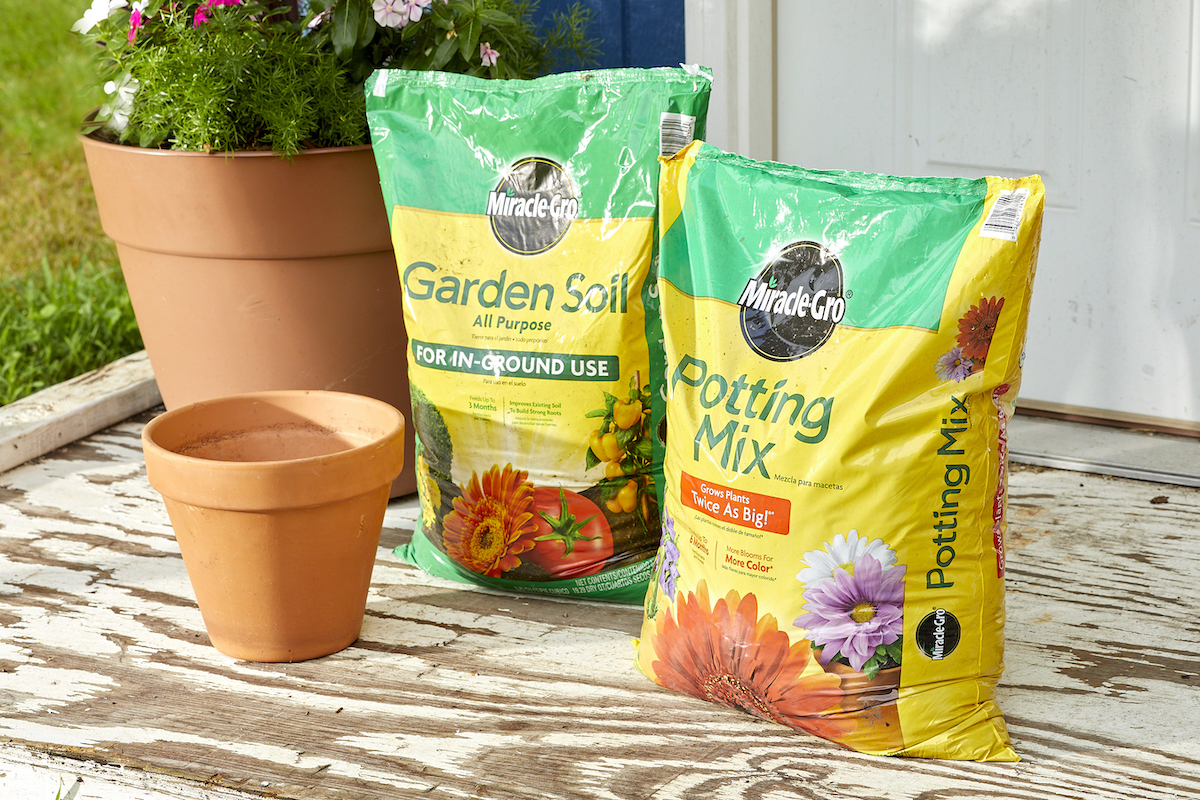

We may earn revenue from the products available on this page and participate in affiliate programs. Learn More ›
If you’re planning a new garden, you should start with good soil. After all, soil is the medium of life for plants, providing a place for roots to spread out and take up water and nutrients. At the garden center, you’ll typically see two bagged options: garden soil and potting soil. Both products are made from quality organic materials. Both products promise to grow strong, healthy plant roots and help you use less water. Yet, while garden soil and potting soil mixes each provide plants with excellent growing conditions, they are not interchangeable.
Garden soil and potting soil are formulated for different applications. Garden soil is an amendment that is mixed with native soil, while potting soil is used alone for container gardens like potted houseplants and window boxes. Choosing the wrong one can lead to problems like moisture buildup and soil compaction, which cause root damage and inhibit plant growth. Ahead, we compare the two options—garden soil vs. potting soil—to help you select the medium that will help your plants thrive.
Garden soil is a blend of topsoil and organic matter.
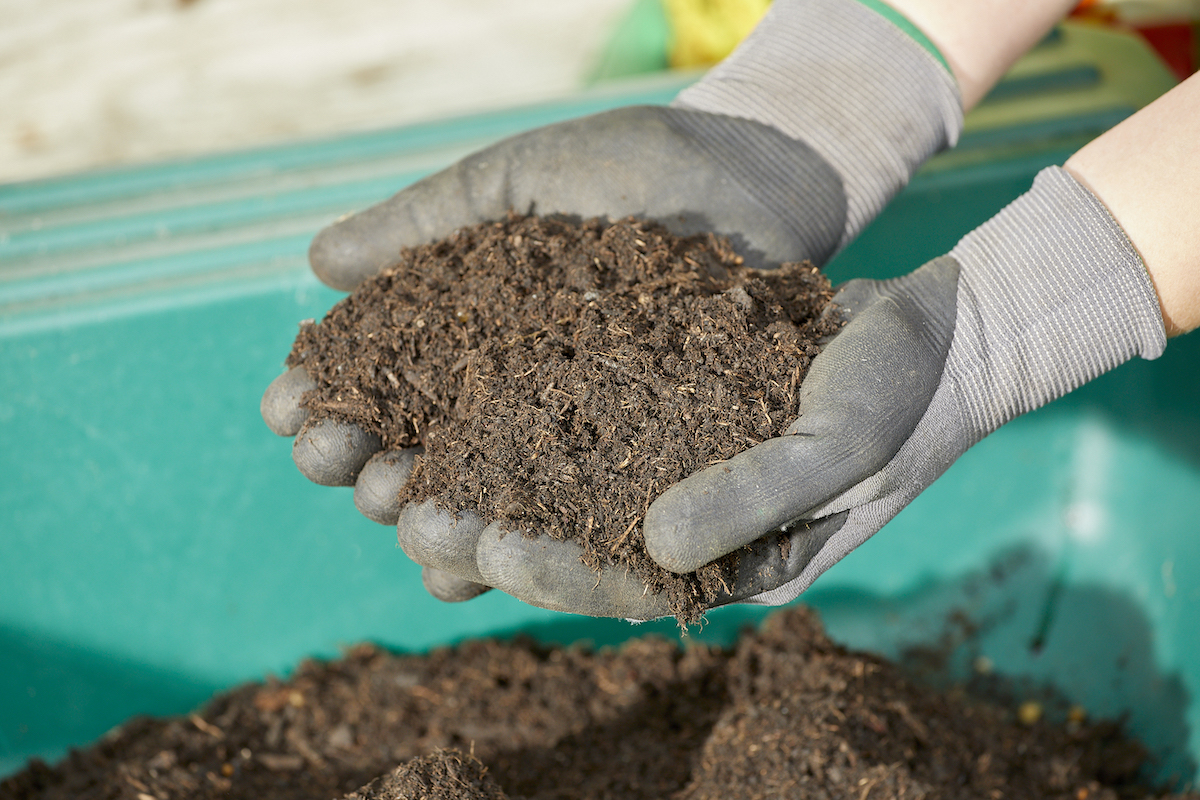
Garden soil is made of natural topsoil or sand blended with relatively inexpensive, bulky organic material. Ingredients like composted bark from mill operations, used mushroom compost, and composted cow or chicken manure are commonly blended into garden soil mixes. The coarse organic matter in garden soil improves the water-holding capacity of sandy soils and loosens the texture of heavy clay soils for better root development in garden beds.
Potting soil provides soil-like conditions for potted plants, with key differences.
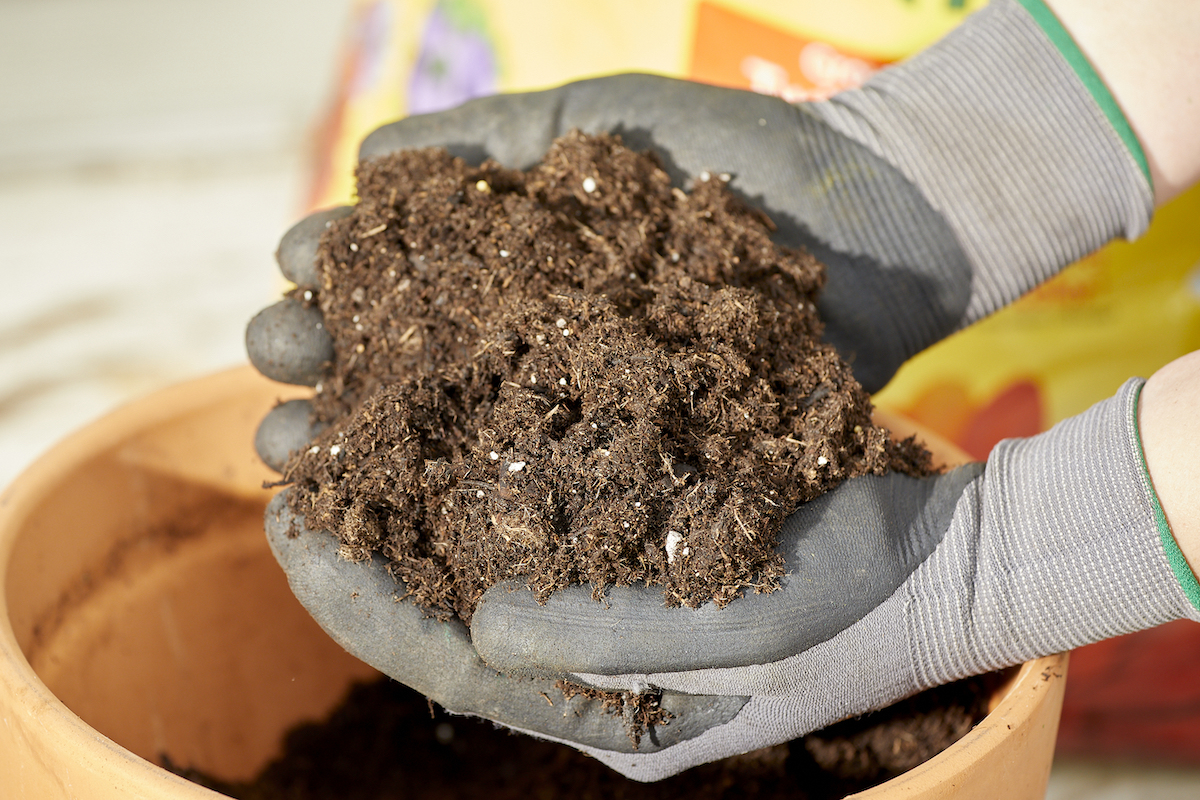
Potting soil may or may not contain actual soil, depending on the blend. Potting mix (vs. potting soil) is a special soilless formula typically made of peat moss, compost, and perlite. Other ingredients might include aged pine bark (similar to compost), vermiculite, coconut coir, and even slow-release fertilizer. Specific mixtures vary, depending on the use. For example, a seed-starting mix might have a higher mixture of perlite, vermiculite, or both to make the soil extra-light in texture.
Organic potting mixes often include composted manure, worm castings, kelp meal, and other natural nutrients. Some potting mixes are acidic, and if they are, limestone might be added to balance the pH. A wetting agent is also added to keep the mix from drying out, because both peat moss and ground pine bark are difficult to wet once they have dried. These ingredients make potting mix a perfect replacement for natural soil when container gardening.
Garden soil improves the texture of natural soil.
Most new gardens don’t have perfect growing conditions. Sandy soil dries out too quickly. Clay soil stays wet too long, but once dry it is difficult to moisten. The bulky organic material in garden soil is meant to be incorporated into the native soil in the garden bed to balance its water retention and drainage abilities, no matter the current texture. It helps sandy soil retain more moisture, and opens the texture of tight clay soil for better drainage.
RELATED: The Best Things You Can Do for Your Garden Soil
Potting mix provides better drainage than garden soil.
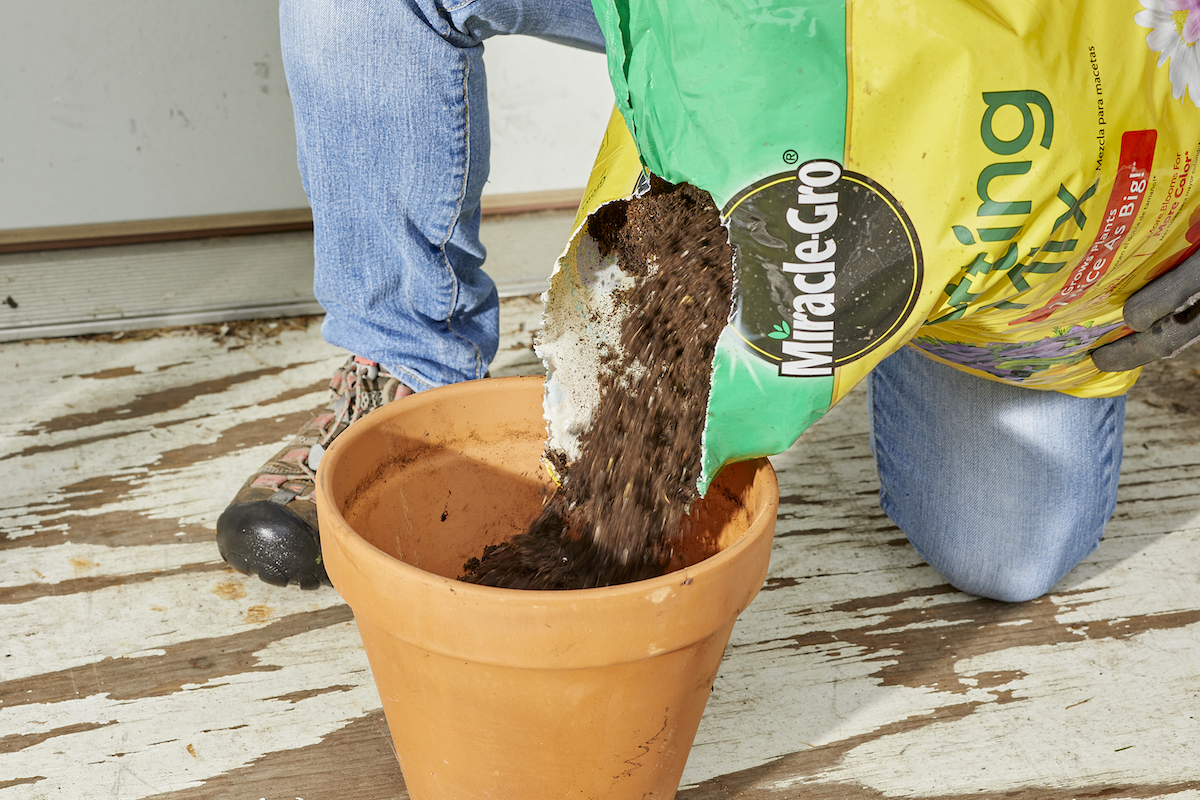
Nearly all plants grown in containers need good drainage, including a way for water to escape the pot and for the growing medium to move water through the soil rather than let roots sit in soggy conditions for days. Well-drained soil is important because both underwatered and overwatered plants can suffer. Waterlogged soil surrounding a plant’s roots robs the roots of the oxygen they need to grow, so the roots die and the plant does not receive the food it needs from below.
When you place any “soil” into a confined container, it eventually compacts because it has only so far to spread, and that compaction can choke roots of oxygen and hold too much water. Potted plants need just the right balance of moist, well-draining soil. Potting mix is formulated to mix organic material and a material such as perlite or vermiculite to allow both air and water to flow through the soil while retaining enough moisture to nourish the plant.
Garden soil is best for outdoor, in-ground applications.
The ideal soil for most plants is loam, which has a balance of sand, silt, and clay. Loam is also rich in an organic matter called humus. Dark and loose but not too loose, humus is composed of decaying organic matter such as plant material and small organisms. The compost and organic materials in commercial garden soil are mixed with topsoil to provide a loamy environment for plants and an all purpose soil for in-ground growing.
To start a new in-ground garden bed, use a tiller or spade to mix a 3-inch layer of garden soil into the top 3 inches of native soil, then plant. If you are planting a single tree or shrub, mix garden soil in a 1:1 ratio with the native soil that you dig out of the hole, and use the mixture to backfill and firm in the new plant.
Well-draining potting soil is best for outdoor container gardens and indoor plants.
Potting mix is for container plantings, indoors or out. Make sure your container has a drain hole in the bottom (and a saucer to protect your floor or patio from water). Cover the drain hole with a few small stones or a piece of mesh to keep soil mix from falling out. Fill the container until nearly full with potting soil or mix, leaving no more than 2 inches of space between the top of the soil and the container rim, less for small pots. Then add seedlings or plants, and firm them in with more potting mix.
Garden soil contains living components.
Another key difference when comparing potting soil vs. garden soil is the presence of soil microbes. Processed minimally, garden soil retains microbes that were in the original natural soil including bacteria, protozoa, fungi, actinomycetes, and nematodes, along with others left over from composting. The mix of microbes includes some types that benefit plants by helping them take up nutrients and water from the soil.
Most weed seeds and harmful microbes are eliminated from garden soil by the heat that is generated during composting. The few microbes that may remain are vastly overshadowed by those existing in native soil. Potting soil types that are soilless contain organic materials and may or may not have additives such as earthworm castings that do contain microorganisms.
Soilless potting mix is a sterile, inert type of potting soil.
Potting mix, sometimes called “soilless mix,” is often devoid of minerals and microbes. Manufacturers of some potting and seed starting soils intentionally sterilize the mix with either heat or chemicals to eliminate any potentially harmful microbes and kill weed seeds. In the absence of beneficial microbes that assist plants with nutrient uptake, potting soil typically includes slow-release plant fertilizer or nutrient-dense organic ingredients like bone meal and kelp meal.
Seed-starting mixes generally do not contain fertilizer, but might be stocked with extra perlite and sometimes vermiculite to keep the mix airy and light. Mixes designed for seed germination have limited organic nutrients to help boost germination but contain no fertilizer, which can actually harm seeds and young seedlings.
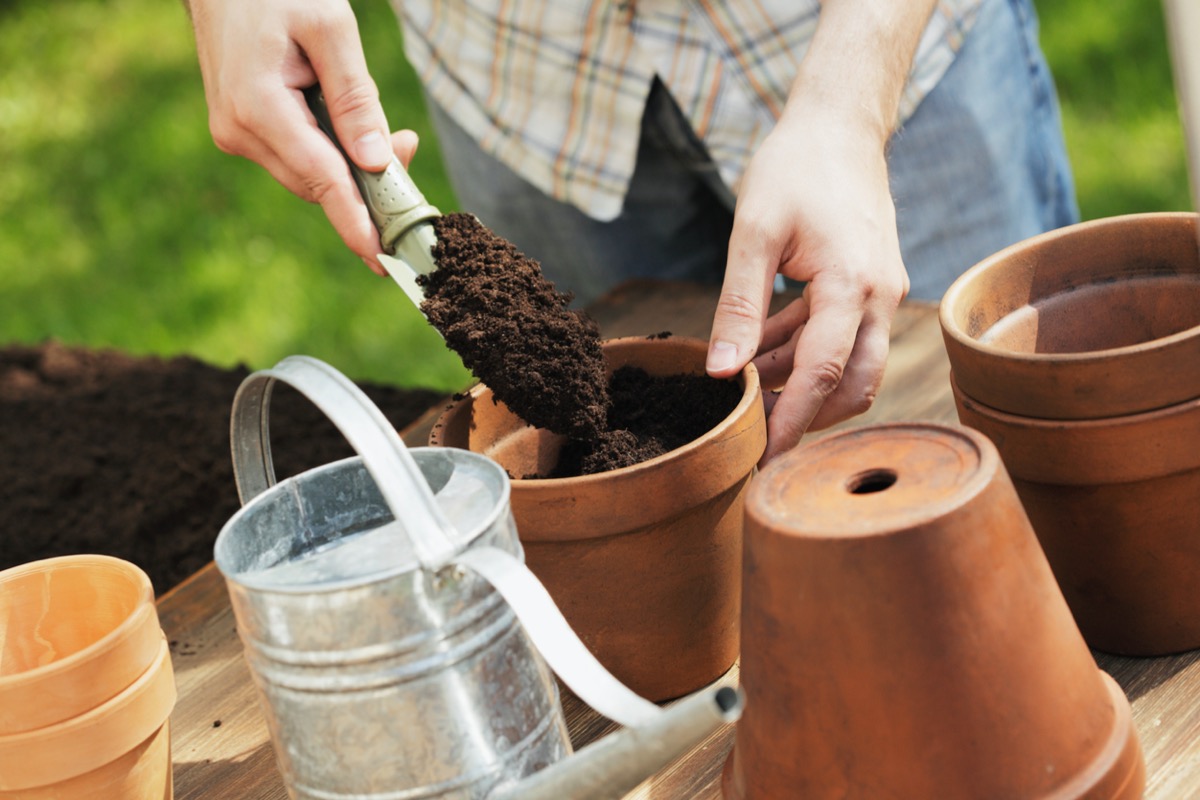
Choose potting soil or garden soil based on your needs, not on the price.
The price of potting soil per unit of volume usually is higher than garden soil, due to the higher level of processing of potting soil and different ingredients. At a nationwide retailer like The Home Depot, a 1.5-cubic foot bag of Miracle Grow garden soil costs $8.97, or $5.98 per cubic foot, while the same manufacturer’s potting mix in a 50-quart bag costs $16.97. (A dry cubic foot is about 26 quarts, which would put the cost of a cubic foot of Miracle Grow potting mix at about $8.82.)
Don’t let cost-cutting sway you from one soil to the other or convince you to buy cheap potting soil. For garden beds in the ground, you’ll always want to choose garden soil and organic compost to build upon and improve the plot’s existing soil. Only choose bags labeled potting soil or potting mix for container-grown plants.
When creating soil for raised beds, consider topsoil vs. potting soil. Although you can start with some topsoil or garden soil, add potting mixes for raised beds as well. Depending on the height and what lies below, raised beds are pretty much giant containers. Start with the right soil and you will lay a foundation for success in your container garden.
DIY potting soil is an affordable alternative to pre-bagged potting soil.
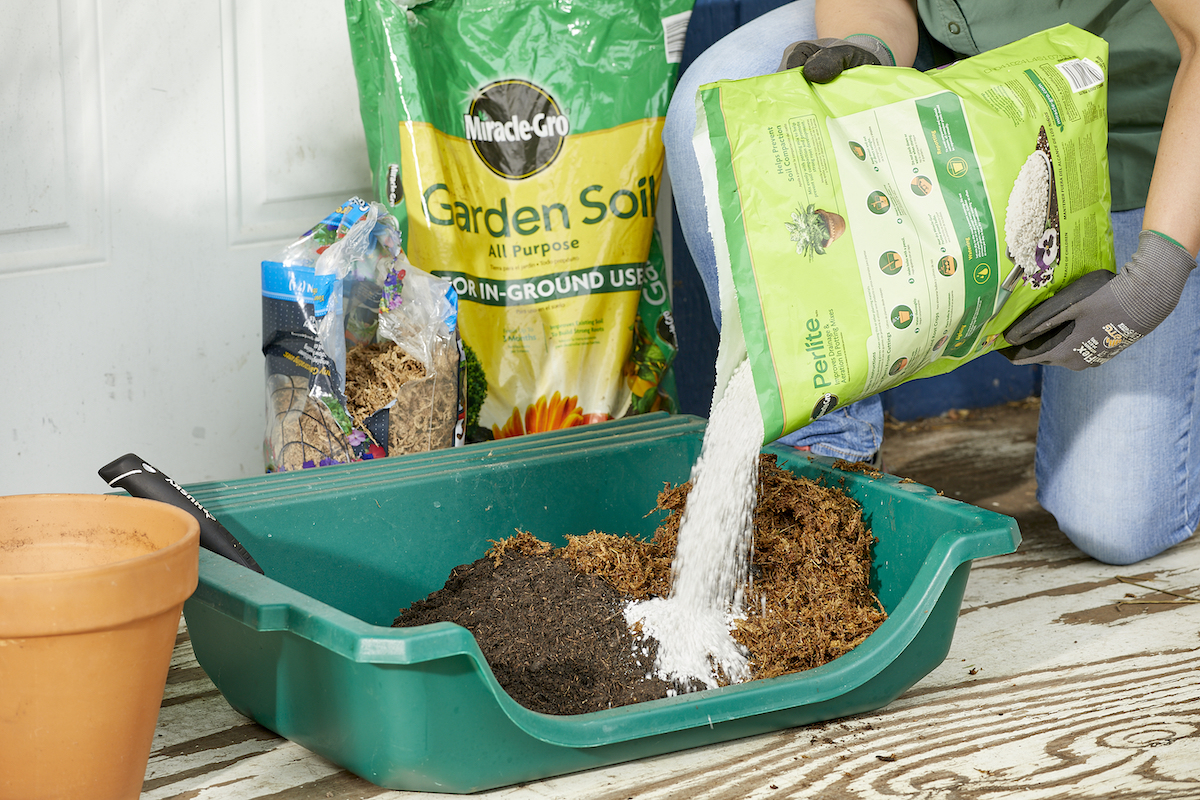
Of course, you can save some money by creating your own potting soil for plants, especially if you already have some of the ingredients on hand. Just be sure to match the mix’s formula to the intended use. PennState Extension suggests that for standard DIY potting soil, start with one bag of garden soil. The reason is it is sterilized and therefore a better starting point than garden dirt from your yard, which can be loaded with tiny diseases, pests, or have poor drainage.
Add one gallon of the garden soil to an equal part of moist, coarse sphagnum peat moss. Then add another gallon of coarse sand, perlite, or vermiculite. After mixing, adjust the ingredients in small amounts to balance any strange look or feel, such as adding more peat moss if the mixture feels too grainy.
For a soilless medium, the best approach is to start with 2 gallons of peat moss, then add 2 gallons of either perlite or vermiculite. Mix it thoroughly and moisten it before using. Finally, some houseplants such as African violets prefer special indoor plant soil mixes that improve drainage even more, so do your homework before diving in.
Organic garden soil is rich in micronutrients and organic matter.
All garden soils and potting soils have some organic matter and micronutrients, but organic garden soil provides plants nutrition solely through addition of decomposed, natural materials. To qualify for certification from the Organic Materials Review Institute, a soil must contain only organic, non-synthetic soil amendments such as compost, manure, and bone meal, for example. It should not contain any synthetic chemicals or fertilizers.
Since garden soil is worked into existing ground soil, it boosts plant-growing properties of turf or soil for garden beds and helps enrich existing dirt. It is not meant as a standalone growing medium for small or large containers.
Organic potting soil is coarser and lighter.
Although garden soil is nutrient-rich, it becomes compacted within the confines of a container, restricting plant growth. Peat-based, soilless mixes became the norm in the past few decades to better meet the needs of germinating seeds and growing plants in containers. Some organic potting soils and mixes contain peat, perlite, and vermiculite, which make the growing medium more coarse than garden soil. Derived from natural materials, these additives are approved in organic potting soils and mixes. While perlite does not add organic nutrients, vermiculite has some potassium, magnesium, and calcium. Ingredients can be organic without being rich in organic matter.
Perlite and vermiculite aerate soil, preventing it from becoming compacted. Perlite is a silicon-rich volcanic rock that improves drainage; vermiculite is a clay mineral that absorbs moisture when a plant is watered, and releases it back to the plant’s roots as the growing medium dries out. Peat moss is decomposed plant matter that comes from bogs and is essential for making potting mix lighter so a container drains well and the soil stays loose and airy. It also helps soil retain some moisture for plants. Coco coir (coconut husks) might be used to replace peat or combined with peat in potting mixes.
